
United Galaxies Council. | Mining Ship. | 
United Galaxies Council. |
|---|
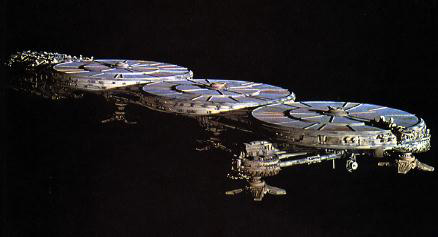 | | A Typical Mining Ship, The Ordinare. |
|---|
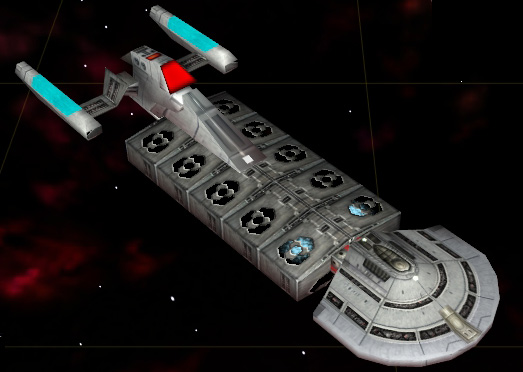 | 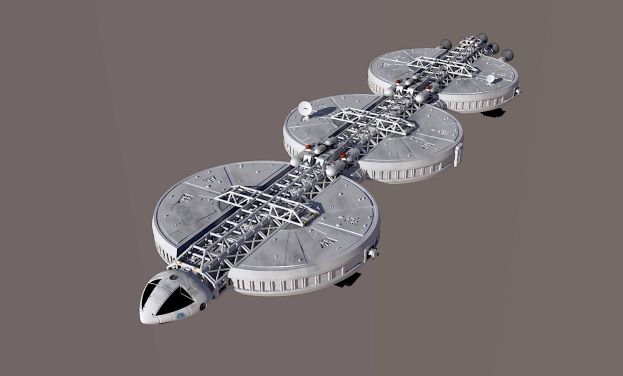 | | A Federate Type-XXVII Freighter Rigged For Mining; Designed post liberation. | A Babylon-Class Governatorial Station Eagle-Class Freighter Rigged For Mining. |
|---|
Even though a Three Star-Class factory ship can, very easily, take a couple of large asteroids, rend them down, and pop out a Veritech Squadron a month later, they rarely do. This is because the efficiency of such a method is practically nil; The extra time and effort needed to rend the asteroid down could be much more efficiently used extra Veritechs, ships, etc. During the earliest phases of a new colony, it may be necessary to rend down the asteroids, until either Mining Ships can be built, or at minimum until they can rend down enough asteroids to begin clearing the docks (produce enough steel and etc to begin ship it). While it is fairly common to start without a Mining Ship, a wisely developed colony makes the building of several such ships a priority."Why vacuum mining?" is a question constantly asked. The answer: Money. It costs 3,000credits per pound up to one ton to send a cargo into space; After one ton, the costs INCREASE to 15,000credits per pound. However, vacuum mining costs about 30,000credits per TON, provided the asteroid selected is a good deposit (comets are inherently good deposits, because they are 90% water, which is the main thing mined in comets). Additionally, some elements only naturally form in space. Finally, removing comets and asteroids from the spacelanes is critical to safe navigation of the spacelanes; Though ships transiting the spacelanes can divert around them, they have to slow or take a circuitous route to avoid them, either way adding time to the transit.Vacuum mining is very hazardous, however; Vacuum miners suffer a one-in-three fatality rate. Because of this, most mining ships are Prison Ships. A few are free ships (that is mining ships that are NOT manned by convicted criminals), but the profit margin for these ships is far less substantial for the effected line; Because of this, most Free Miners (as they're called) tend to be independent, and more often than not are double-use ships (one in the Restadt System, is also a medical research facility). The mining is simply used to add to the overall profit margin, or simply to supply the ship with metals they need.Note that there is no one class of Mining ships; Almost every single ship is different, and there are no more than 20 identical ones.Type: Heavy Industrial ShipClass: MiningCrew: Varies by ship; As little as 10,000 to 10 times that number.MDC By Location: SPECIAL: Each ship has slightly different stats; Follow these general guidelines: |
Main Hull:
Bridge: | Varies by ship; Generally about 100 per every crewman.
Varies by ship; Generally 1 per every 100 Hull MDC. | Hatches: | Large through-hull hatches have 500 MDC, smaller internal hatches, doors, and scuttles generally only about 100. The exact number of hatches, doors, and scuttles vary, but two large through-hull hatches and 10-100 smaller, humanoid-sized through-hull hatches are common. |
| Speed and Statistical Data: |
Space Fold: Not Equipped (though they have been equipped with spacefolds occasionally, they in theory shouldn't need it).
FTL: Factor 5
Cruising Speed: Mach 2 to Mach 20; The approach speed of the ship will be equal to the speed of the target to be mined.
Ground Speed: Typically very slow indeed, as little as 1/2mph until the ships leave the planet to return to orbit.
Clearance: Varies; Generally 30 to 50 feet.
Beam: Generally 11/2 to 5 times the clearance.
Length: Varies, however shorter vsls tend to fit into the niches better, so rarely are they more than three times the length of their beam.
Weight: Varies. Generally about 1 ton per every 100 crewmen.
Cargo: Varies; Generally about 100 tons of ore per every ton of vsl.
Cruise Duration: Varies; Generally about 5 years (prison ships usually go a lot longer). | Power Plant:Primary: Various nuclear reactors; Out put varies greatly.Secondary: Solar panel arrays; Often used in place of the main power plant, since it's free, if circumstances permit. When otherwise, it is generally used only in emergencies.Tertiary: Battery back up. These are only used in GRAVE emergencies, but have a full six-week capability at basic life-support levels.
Propulsion:Primary: Tractioning drives;Secondary: Rocket power
Flight System: Not Applicable; Not planet-fall capable.
Cost and Availability:Every crewman equals about 20credits towards construction cost; Takes about 3 months to build.
Black Market Cost and Availability: Varies VERY greatly; Only ships stolen from somewhere else would be available on the black market, and since these are pretty big ships, it's hard to off-load one. However, malconts often swap these and other vsls between each other for various purposes.
|
| Weapons Systems:Because these ARE civilian vsls, they are rarely armed with anything but the most basic self-defense mechanisms. |
1. Full-Force Barrier Field: This type of vsl generally has a full-force barrier field, but only a fairly light and rudimentary one.
MDC: Generally not more than about 150 to 500
Range: Self + about 10 feet.
Payload: Technically unlimited; However, the barrier field prevents ANY approach to the vsl, and therefore must be lowered to allow cargo shuttles, in.
Attacks Per Melee: Technically unlimited; Requires one melee action to raise, if the operator happens to be standing right there when the attack begins. Sadly, all too often they are not. | 2. Point Defense Lasers: These automated laser batteries kick in whenever the Collision alarm alerts. Rarely are there more than four, though.
MD: 1D4 times 10 per blast.
Range: 100 feet.
Payload: Unlimited.
Attacks Per Melee: Twice per melee.
|
| Features: |
- 1 MC (loudspeaker): Internal loudspeaker.
- ESM: Radar Detector. Passively detects other radars being operated.
- Radar: Civilian grade radar. Range 1000 miles, can track up to 50 individual targets. 80% reliability (00% against unfriendly stealthed vehicles).
- AMC/FD (2): Anti-Missile Chaff/Flare Dispensers. Actually launches a glob of burning magnesium/aluminum alloy to confuse both radar AND heat sensory systems. Fires off 04 chaff/flares each time it is activated. The system is KNOWN to work on all KNOWN radar and infrared systems, but concerns continue that somewhere out there their MIGHT be a system that will be totally unaffected by the system. Reduce effects by 20% against smart missiles (add +20% to rolls for smart missiles).
- Effect:
- 01-50 Enemy missile or missile volley detonates in chaff cloud- Missiles are all destroyed.
- 51-
75 Enemy missile or missile volley loses track of real target and veers away in wrong direction (may lock onto another target).76-00 No effect, missile is still on target.- Also note that the chaff cloud will also blind nearby heat sensors (and optically based sensors at night) for 1 melee. They will suffer the following penalties: Reduce melee attacks/actions, and combat bonuses by half.
- Duration: 1D4 melee rounds.
- Payload: 120 chaff/flares. Each time the system is engaged, the system fires off 04 chaff/flares.
- Video Camera: Records from the HUD. 50 hours of recording available.
| - HUD: Displays maps, radar, targeting information, and any OTHER information the crew member wants directly in front of them.
- FLIR/SLIR: Forward and Side Looking Infrared. Allows crew to get visuals at night and in deep space.
- Virtual Map: Displays a continuously-updating map of all bodies ahead for the pilot. Takes data from and gives data to other ships in the area. Effective navigation of 85% as updates come. Good to 500 miles. Specific range can be adjusted in 1 mile increments.
- Full range optic sensory suite: Infrared, ultra violet, Magnification, night sight, color filters, thermal imager. Range is about 200 miles for MOST sensors.
- Escape Pods: There are SUPPOSED TO BE 1 10-man pod per every 5 crewmembers. And once in a while there are.
- Survival Pack: A pack of simpler emergency survival supplies: Pup tent, sleeping bag, black light, GPS, first aid kit (bandages, gauze, bandage tape, pads, antiseptic/analgesic), plasma torch (for small repairs and starting fires), repair kit (with MDC Repair Spray), sewing kit (a small spool of thread and 5 needles),
7 star flares (250 foot apogee), 100 feet of black or brown parachute cord (150 lbs tensile strength; This is in addition to several hundred feet from their parachute itself), 2-5 days rations, 2 gallons water, water purification kit (good for about 10 gallons), manual-inflating liferaft (for at-sea abandonment), self-inflating lifevest (15# buoyancy). The liferaft can also double as a Pup Tent if so desired (though most pilots prefer to use a parachute for that, if anything, due to the fact that it is easier to hide). Typically kept with the escape pods. Not that a pup tent has very little use in hard vacuum, but can be handy if you crash land on a planet unexpectedly. - EPIRB: Emergency Position Indicating Radio Beacon; An automated distress buoy that can be jettisoned in the event of massive catastrophe. Mining ships are unique for having these, as they tend to settle into a given asteroid for years at a time, and are therefore relatively stagnant and can be found, if the circumstances require. To date, EPIRBS have been used only in 10% of all emergencies, and all of these have been CRITICAL; Fire on board ship.
|
Combat Profile for an average Mining Ship:- 2 attacks per melee for automated laser batteries.
- 4 attacks per melee for the pilots (dodges/parries only; only applies when actually underway, not when anchored to an asteroid).
- +3 to strike
- +2 to parry (only applies when actually underway, not when anchored to an asteroid).
- +2 to dodge (only applies when actually underway, not when anchored to an asteroid).
|
| Noteworthy Examples. |
|---|

Kobolese Confederation. | VENATOR-Class Conversion. | 
Kobolese Confederation. |
|---|
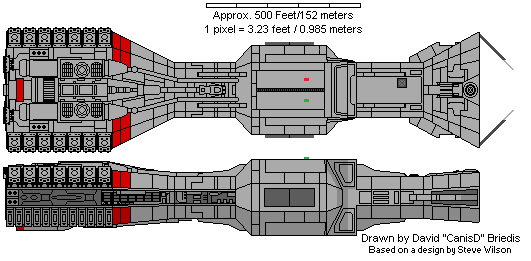 | | A VENATOR-Class Mining Ship convert. |
|---|
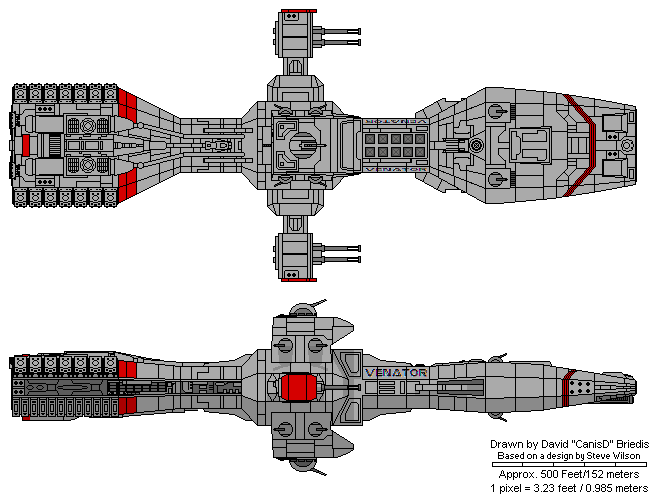 | | Original Configuration. |
|---|
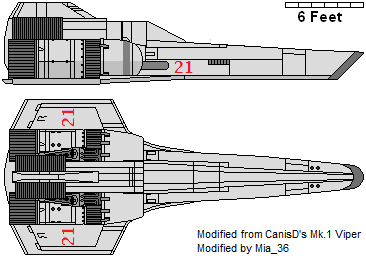 | | Original Configuration. |
|---|
The Kobolese came into possession of the VENATOR-Class when the Children Of Zoe defected; The ships were rated as "not sufficient for further militry application," and were planned to be scrapped, when a First Class Petty Officer in the Kobolese Fleet suggested converting them to mining ships instead.The ship was cut down at frame 28, leaving a gaping maw where before the ship's hull had been; Into this hole was laid some armor plate taken from what had been hull armor to serve as a kind of funnel, directing rocks into growlers, high-compression, high-speed crushers that systemically reduced the rocks from 20 foot across (the size of the funnel opening) to the size of the tip of a man's pinky finger. During transit, the funnel is covered by a bow doors, 4 of them arranged so that in the open position they further funnel material into the hull. (They also extend outward in the open position, effectively tripling the size of the funnel.) When the bow doors are open a basic atmospheric force field is engaged to contain the air. During approach, a gravity well generator is swung in front of the funnel's opening, drawing the rocks in in conjunction with "tug" fighters (old Viper Fighters that have been converted for this operation). Once the gravity waves have begun drawing them in, inertia keep them coming right down the funnel and into the growlers; The grav pod is then secured and swung it out of the way so it doesn't get damaged. As the growlers break the rocks down they are simply pack them into whatever space is available. The ships return to their station once full.An interesting twist is the control station (normally called a bridge); With the bridge of the old ship gone, a pair of docking well were cut into the hull that a shuttle could mate to (ventral to dorsal) making a very hard dock. The shuttle's "crew" then opens an underside hatch, wherein shore ties are located. The shuttle's controls then over ride the ship's, making the shuttle itself essentially the bridge. Due to the VERY small size of the mining' ships crew (6) and ample room of the shuttle (they can carry up to 20) the shuttle also serves as the berthing area, though an early expriemnt to use them as berthing, galley, and messdeck failed to pass muster with the kind of results that supporters of the program had hoped for, and part of the original destroyers were converted to galley and messdeck. (The original conversion galley was kept, however, as a coffee mess only.) The shore ties allow the shuttle's sewage to transfer over, the powerplant to be brought to absolute idle, etc., while the shuttle's controls serves as the ship's controls. Because the scales involved in the original proposal drawings only allowed "basic" marking for the shuttles, a simple "red" and "green" mark was made to indicated where the shuttles would dock, the idea being that the two shuttles would swap out crews on about a two week basis. Due to the colors of the marks, the crews developed a nomenclature of "Red Crews" and "Green Crews," with no real significance beyond that.Due to concerns about the ship's being often HIGHLY isolated (even beyond the red line), a secondary AND tertiary FTL drive was installed, but if all else failed the crew could board the shuttles, disengage the shore ties rather directly by cutting them or simply pulling away and ripping them free, abandon the ship, and just jump away. Loosing the mining ship was considered a minor concern, since they would still have the crew (and the logs from the ship's activities recorder, which are NOT kept on the ship itself but rather the shuttles).Mining Drills; In mining, a "drill" is anything intended to bore holes. Discussions on the subject of the mining drill took place, with the idea of using a laser being favored by some, while the idea of using a rail gun loaded with "dross rounds" (literally slugs made of dross from mining operations) being favored by others; In the end, both types of drills were installed, on the prototype being a rail gun built from scraps off the original destroyer (the barrel was reported to have been a section of sewage piping) and the main drills, but lasers for secondary drills (to re-drill the rocks). In the normal course of operations, the secondary drills are used far more often, since it's easier to select rocks small enough for the lasers to deal with anyways, but the lasers are power-hungry and can not be used on larger rocks (over 10 miles across) with reliability.These ships are neither fast nor glamourous, and they don't have to be; They're black hulls, working boats, each and every one has dents and dings and rusted hull and everything ELSE a pleasure cruise WOULDN'T have, and then some, and nobody cares too much about that. They DO however, care about CLEANLINESS; Besides crew health reasons, coal and other explosive and or flammable materials occasionally form in asteroids, and as such each ship must be personally inspected and certified for underway operations before leaving port by at least a fleet Captain ("Commander" under the Kobolese militry system), to ensure they are in fact safe for operations. Originally fitted for a crew of 8 for worst case scenarios, the berthing was increased over time to a total of 12, with two being permanent crew members (the Captain and the Chief engineer/Executive Officer), who's berthing is permanently onboard the ship.Mining Mission; A selected rock is identified, typically using the mining vipers, and approached; At a distance of about 10,000 miles the rail gun gun is fired at the target if needed to smash it down. The rail guns are an extremely low-energy type, since they sit there all damned day drilling the target- It's not like it's gonna fight back. Once it's sufficiently broken down, the mining vipers are flown to a position between the ship and the rocks, and their grav pods energized; This "tickles" the rocks, causing them to follow the viper towards the ship's maw. Once the rocks are well on their way towards the ship, the grav pod is secured and the vipers turn away from the ship (usually to port). If needed, the maw's grav pod is energized to boost the draw, otherwise the atmospheric shield is energized and the grav pod is swung out of the way. Most often, the pod is already out of the way, especially if the rail gun was in fact used, since they use the same opening. The lasers are then swung into place to ensure nothing is too big to fit into the maw, but otherwise it's simply a matter of waiting for them to come in. the rocks, which now should be no more than 20 feet across (otherwise they won't fit into the maw) are then fed into "growlers," machines consisting of a series of progressively smaller cams which crush the rocks to a maximum size on 1/2" across. The pure fact of the equipment running is extraordinarily LOUD, even under vacuum conditions, from the vibrations of the equipment running; As a result, crew are directed not be in that area during grinding operations unless specifically so directed. Early proposals to include smelters were over ruled, though a later fleet of slightly larger ships dedicated solely to smelting were retrofitted.As the rocks are brought on and crushed, they pass through several bulkheads; As a protective measure, the through-bulkhead fittings they pass through have twin quick-acting airtight doors in case of emergency. The lead edge of the doors are very hard and VERY sharp, allowing them to cut through the untreated steel plates that make up the conveyor belts; Originally they cut through the support rails as well, but the rails were later cut out in such a way that they were no longer and issue, making the conveyor belt plates the only casualty of such an operation. In each suck space is installed a panic room, capable of supplying air to any crewmen trapped in there until they can be rescued. The through-bulkhead fitting serve a secondary purpose of quality control; If a rock can not fit though the door, it's too big to proceed on and is sent back trhough the growlers in the area until it will fit. As the last of the rock is collected, the grav pod is swung back into place, pulling double-duty as the airlock hatch. When a full load is collected, the bow doors as closed as well, and the ship prepares to return to port. If the distances in question are sufficiently small, the ship could still be crushing rocks while being off loaded, though more often they are just finishing up the last of the rocks when the ship ties up.These ships routinely find water and energy sources; The water is stowed in the form of ice, the energy sources are stowed in containers suitable to the type of energy source. As already discussed, they occasionally find coal; This is packed into steel boxes as tightly as possible, which makes them air tight in their own right, but is also then stowed in the thruster compartments, giving them additional pressure and heat, increasing their carbon content and thus making them more efficient power sources.Mining Shuttles; Typically older standard shuttles that are no longer fully serviceable, they are rebuilt with 10 (originally 6) fold up racks fitted with strap-retained air augmented mattresses, a small galley almost on par with a raptors but with a slightly larger reefer, and a table that can be swung 90° to double as a white board for meetings, etc. Actually, the table can be swung either way, potentially allowing it to be used for a projection partition for a morale event (it's also ping-pong regulation size). The crew, minus the Captain and CEXO (referred to as the "check-o" or "checks-o"), sleep and generally work on the shuttle, though occasionally go into the ship itself (twice per day for inspection rounds, and "as needed" for repairs).The VENATOR-Class is mostly noteworthy for their longevity of service (the original is still going strong after 6,000+ years) and for their relatively limited dangers; Whereas a typical mining sip suffers a one in three death rate, the VENATORS suffer a 1 in TEN THOUSAND death rate, making them amongst the safest occupations in known galaxies (safer even than being an REF member). |









